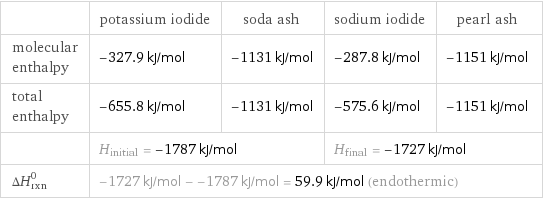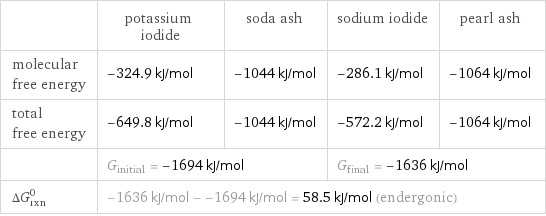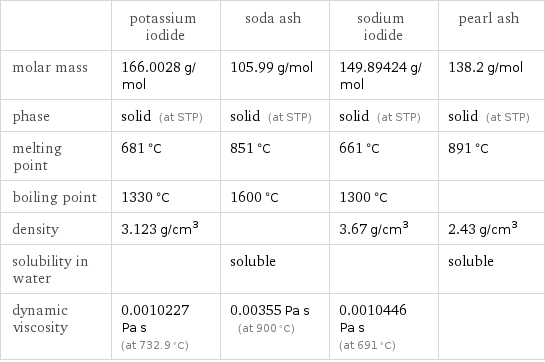Input interpretation

KI potassium iodide + Na_2CO_3 soda ash ⟶ NaI sodium iodide + K_2CO_3 pearl ash
Balanced equation

Balance the chemical equation algebraically: KI + Na_2CO_3 ⟶ NaI + K_2CO_3 Add stoichiometric coefficients, c_i, to the reactants and products: c_1 KI + c_2 Na_2CO_3 ⟶ c_3 NaI + c_4 K_2CO_3 Set the number of atoms in the reactants equal to the number of atoms in the products for I, K, C, Na and O: I: | c_1 = c_3 K: | c_1 = 2 c_4 C: | c_2 = c_4 Na: | 2 c_2 = c_3 O: | 3 c_2 = 3 c_4 Since the coefficients are relative quantities and underdetermined, choose a coefficient to set arbitrarily. To keep the coefficients small, the arbitrary value is ordinarily one. For instance, set c_2 = 1 and solve the system of equations for the remaining coefficients: c_1 = 2 c_2 = 1 c_3 = 2 c_4 = 1 Substitute the coefficients into the chemical reaction to obtain the balanced equation: Answer: | | 2 KI + Na_2CO_3 ⟶ 2 NaI + K_2CO_3
Structures

+ ⟶ +
Names

potassium iodide + soda ash ⟶ sodium iodide + pearl ash
Reaction thermodynamics
Enthalpy

| potassium iodide | soda ash | sodium iodide | pearl ash molecular enthalpy | -327.9 kJ/mol | -1131 kJ/mol | -287.8 kJ/mol | -1151 kJ/mol total enthalpy | -655.8 kJ/mol | -1131 kJ/mol | -575.6 kJ/mol | -1151 kJ/mol | H_initial = -1787 kJ/mol | | H_final = -1727 kJ/mol | ΔH_rxn^0 | -1727 kJ/mol - -1787 kJ/mol = 59.9 kJ/mol (endothermic) | | |
Gibbs free energy

| potassium iodide | soda ash | sodium iodide | pearl ash molecular free energy | -324.9 kJ/mol | -1044 kJ/mol | -286.1 kJ/mol | -1064 kJ/mol total free energy | -649.8 kJ/mol | -1044 kJ/mol | -572.2 kJ/mol | -1064 kJ/mol | G_initial = -1694 kJ/mol | | G_final = -1636 kJ/mol | ΔG_rxn^0 | -1636 kJ/mol - -1694 kJ/mol = 58.5 kJ/mol (endergonic) | | |
Equilibrium constant
![Construct the equilibrium constant, K, expression for: KI + Na_2CO_3 ⟶ NaI + K_2CO_3 Plan: • Balance the chemical equation. • Determine the stoichiometric numbers. • Assemble the activity expression for each chemical species. • Use the activity expressions to build the equilibrium constant expression. Write the balanced chemical equation: 2 KI + Na_2CO_3 ⟶ 2 NaI + K_2CO_3 Assign stoichiometric numbers, ν_i, using the stoichiometric coefficients, c_i, from the balanced chemical equation in the following manner: ν_i = -c_i for reactants and ν_i = c_i for products: chemical species | c_i | ν_i KI | 2 | -2 Na_2CO_3 | 1 | -1 NaI | 2 | 2 K_2CO_3 | 1 | 1 Assemble the activity expressions accounting for the state of matter and ν_i: chemical species | c_i | ν_i | activity expression KI | 2 | -2 | ([KI])^(-2) Na_2CO_3 | 1 | -1 | ([Na2CO3])^(-1) NaI | 2 | 2 | ([NaI])^2 K_2CO_3 | 1 | 1 | [K2CO3] The equilibrium constant symbol in the concentration basis is: K_c Mulitply the activity expressions to arrive at the K_c expression: Answer: | | K_c = ([KI])^(-2) ([Na2CO3])^(-1) ([NaI])^2 [K2CO3] = (([NaI])^2 [K2CO3])/(([KI])^2 [Na2CO3])](../image_source/8d604f9882613d5023b1cd6e43a7ed1a.png)
Construct the equilibrium constant, K, expression for: KI + Na_2CO_3 ⟶ NaI + K_2CO_3 Plan: • Balance the chemical equation. • Determine the stoichiometric numbers. • Assemble the activity expression for each chemical species. • Use the activity expressions to build the equilibrium constant expression. Write the balanced chemical equation: 2 KI + Na_2CO_3 ⟶ 2 NaI + K_2CO_3 Assign stoichiometric numbers, ν_i, using the stoichiometric coefficients, c_i, from the balanced chemical equation in the following manner: ν_i = -c_i for reactants and ν_i = c_i for products: chemical species | c_i | ν_i KI | 2 | -2 Na_2CO_3 | 1 | -1 NaI | 2 | 2 K_2CO_3 | 1 | 1 Assemble the activity expressions accounting for the state of matter and ν_i: chemical species | c_i | ν_i | activity expression KI | 2 | -2 | ([KI])^(-2) Na_2CO_3 | 1 | -1 | ([Na2CO3])^(-1) NaI | 2 | 2 | ([NaI])^2 K_2CO_3 | 1 | 1 | [K2CO3] The equilibrium constant symbol in the concentration basis is: K_c Mulitply the activity expressions to arrive at the K_c expression: Answer: | | K_c = ([KI])^(-2) ([Na2CO3])^(-1) ([NaI])^2 [K2CO3] = (([NaI])^2 [K2CO3])/(([KI])^2 [Na2CO3])
Rate of reaction
![Construct the rate of reaction expression for: KI + Na_2CO_3 ⟶ NaI + K_2CO_3 Plan: • Balance the chemical equation. • Determine the stoichiometric numbers. • Assemble the rate term for each chemical species. • Write the rate of reaction expression. Write the balanced chemical equation: 2 KI + Na_2CO_3 ⟶ 2 NaI + K_2CO_3 Assign stoichiometric numbers, ν_i, using the stoichiometric coefficients, c_i, from the balanced chemical equation in the following manner: ν_i = -c_i for reactants and ν_i = c_i for products: chemical species | c_i | ν_i KI | 2 | -2 Na_2CO_3 | 1 | -1 NaI | 2 | 2 K_2CO_3 | 1 | 1 The rate term for each chemical species, B_i, is 1/ν_i(Δ[B_i])/(Δt) where [B_i] is the amount concentration and t is time: chemical species | c_i | ν_i | rate term KI | 2 | -2 | -1/2 (Δ[KI])/(Δt) Na_2CO_3 | 1 | -1 | -(Δ[Na2CO3])/(Δt) NaI | 2 | 2 | 1/2 (Δ[NaI])/(Δt) K_2CO_3 | 1 | 1 | (Δ[K2CO3])/(Δt) (for infinitesimal rate of change, replace Δ with d) Set the rate terms equal to each other to arrive at the rate expression: Answer: | | rate = -1/2 (Δ[KI])/(Δt) = -(Δ[Na2CO3])/(Δt) = 1/2 (Δ[NaI])/(Δt) = (Δ[K2CO3])/(Δt) (assuming constant volume and no accumulation of intermediates or side products)](../image_source/81e2a44a49ccd43ddfc63d8fd8925c14.png)
Construct the rate of reaction expression for: KI + Na_2CO_3 ⟶ NaI + K_2CO_3 Plan: • Balance the chemical equation. • Determine the stoichiometric numbers. • Assemble the rate term for each chemical species. • Write the rate of reaction expression. Write the balanced chemical equation: 2 KI + Na_2CO_3 ⟶ 2 NaI + K_2CO_3 Assign stoichiometric numbers, ν_i, using the stoichiometric coefficients, c_i, from the balanced chemical equation in the following manner: ν_i = -c_i for reactants and ν_i = c_i for products: chemical species | c_i | ν_i KI | 2 | -2 Na_2CO_3 | 1 | -1 NaI | 2 | 2 K_2CO_3 | 1 | 1 The rate term for each chemical species, B_i, is 1/ν_i(Δ[B_i])/(Δt) where [B_i] is the amount concentration and t is time: chemical species | c_i | ν_i | rate term KI | 2 | -2 | -1/2 (Δ[KI])/(Δt) Na_2CO_3 | 1 | -1 | -(Δ[Na2CO3])/(Δt) NaI | 2 | 2 | 1/2 (Δ[NaI])/(Δt) K_2CO_3 | 1 | 1 | (Δ[K2CO3])/(Δt) (for infinitesimal rate of change, replace Δ with d) Set the rate terms equal to each other to arrive at the rate expression: Answer: | | rate = -1/2 (Δ[KI])/(Δt) = -(Δ[Na2CO3])/(Δt) = 1/2 (Δ[NaI])/(Δt) = (Δ[K2CO3])/(Δt) (assuming constant volume and no accumulation of intermediates or side products)
Chemical names and formulas

| potassium iodide | soda ash | sodium iodide | pearl ash formula | KI | Na_2CO_3 | NaI | K_2CO_3 Hill formula | IK | CNa_2O_3 | INa | CK_2O_3 name | potassium iodide | soda ash | sodium iodide | pearl ash IUPAC name | potassium iodide | disodium carbonate | sodium iodide | dipotassium carbonate
Substance properties

| potassium iodide | soda ash | sodium iodide | pearl ash molar mass | 166.0028 g/mol | 105.99 g/mol | 149.89424 g/mol | 138.2 g/mol phase | solid (at STP) | solid (at STP) | solid (at STP) | solid (at STP) melting point | 681 °C | 851 °C | 661 °C | 891 °C boiling point | 1330 °C | 1600 °C | 1300 °C | density | 3.123 g/cm^3 | | 3.67 g/cm^3 | 2.43 g/cm^3 solubility in water | | soluble | | soluble dynamic viscosity | 0.0010227 Pa s (at 732.9 °C) | 0.00355 Pa s (at 900 °C) | 0.0010446 Pa s (at 691 °C) |
Units
